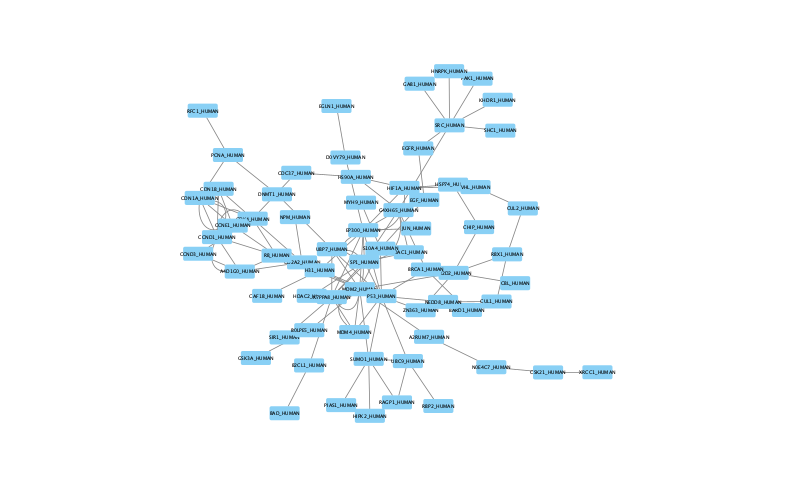Beginner Tutorial - Set up & Running One Algorithm
This tutorial provides a hands-on introduction to SPRAS. It is designed to show participants how to install the software, run example workflows, and use tools to interpret the results.
You will learn how to:
Set up the SPRAS software environment
Explore the folder structure and understand how inputs, configurations, and outputs are organized
Configure and run a pathway reconstruction algorithm on a provided dataset
Enable post-analysis steps to generate post analysis information
Step 0: Clone the SPRAS repository, set up the environment, and run Docker
0.1 Clone the SPRAS repository
Visit the SPRAS GitHub repository and clone it locally
0.2 Set up the SPRAS environment
From the root directory of the SPRAS repository, create and activate the Conda environment and install the SPRAS python package:
conda env create -f environment.yml
conda activate spras
python -m pip install .
Note
The first command performs a one-time installation of the SPRAS dependencies by creating a Conda environment (an isolated space that keeps all required packages and versions separate from your system).
The second command activates the newly created environment so you can use these dependencies when running SPRAS; this step must be done each time you open a new terminal session.
The last command is a one-time installation of the SPRAS package into the environment.
0.3 Test the installation
Run the following command to confirm that SPRAS has been set up successfully from the command line:
python -c "import spras; print('SPRAS import successful')"
0.4 Start Docker
Before running SPRAS, make sure Docker Desktop is running.
Launch Docker Desktop and wait until it says “Docker is running”.
Note
SPRAS itself does not run inside a Docker container. However, Docker is required because SPRAS uses it to execute individual pathway reconstruction algorithms and certain post-analysis steps within isolated containers. These containers include all the necessary dependencies to run each algorithm or post analysis.
Step 1: Configuration files
A configuration file specifies how a SPRAS workflow should run; think of it as the control center for the workflow.
It defines which algorithms to run, the parameters to use, the datasets and gold standards to include, the analyses to perform after reconstruction, and the container settings for execution.
The configuration files used are written in YAML, a human-readable format that uses simple indentation and key-value pairs for data seralizaiton.
SPRAS uses Snakemake to read the YAML configuration file and execute a SPRAS workflow accordingly.
1.1 Save config for this tutorial
For this part of the tutorial, we’ll use a pre-defined configuration file.
Download it here: Beginner Config File
Save the file into the config/ folder of your SPRAS installation.
After adding this file, your directory structure will look like this (ignoring the rest of the folders):
spras/
├── config/
│ ├── beginner.yaml
│ └── ... other configs ...
├── inputs/
│ ├── phosphosite-irefindex13.0-uniprot.txt # pre-defined in SPRAS already, used by the beginner.yaml file
│ ├── tps-egfr-prizes.txt # pre-defined in SPRAS already, used by the beginner.yaml file
│ └── ... other input data ...
config/
The config/ folder stores configuration files for SPRAS.
Note
You can store configuration files anywhere, as long as you provide the correct path when running SPRAS (explained later in this tutorial).
inputs/
The inputs/ folder contains input data files.
You can use the provided example datasets or add your own for custom experiments to this folder.
Note
Input files can be stored anywhere as long as their paths are correctly referenced in the configuration file (explained later in this tutorial).
1.2 Overview of the major sections of a configuration file:
Algorithms
algorithms:
- name: omicsintegrator1
params:
include: true
run1:
b: 0.1
d: 10
g: 1e-3
run2:
b: [0.55, 2, 10]
d: [10, 20]
g: 1e-3
When defining an algorithm in the configuration file, its name must match one of the supported SPRAS algorithms. Each algorithm includes an include flag, which you set to true to have Snakemake run it, or false to disable it.
Algorithm parameters can be organized into one or more run blocks (e.g., run1, run2, …), with each block containing key-value pairs. When defining a parameter, it can be passed as a single value or passed by listing parameters within a list. If multiple parameters are defined as lists within a run block, SPRAS generates all possible combinations (Cartesian product) of those list values together with any fixed single-value parameters in the same run block. Each unique combination runs once per algorithm.
Each algorithm exposes its own set of parameters that control its optimization strategy. Some algorithms have no adjustable parameters, while others include multiple tunable settings that influence how subnetworks are created. These parameters vary widely between algorithms and reflect the unique optimization techniques each method employs under the hood.
(See Pathway Reconstruction Methods for information about algorithms and their parameters).
Datasets
datasets:
-
label: egfr
node_files: ["prizes.txt", "sources-targets.txt"]
edge_files: ["interactome.txt"]
other_files: []
data_dir: "input"
In the configuration file, datasets are defined under the datasets section. Each dataset you define will be run against all of the algorithms enabled in the configuration file.
A dataset must include the following types of keys and files:
label: a name that uniquely identifies a dataset throughout the SPRAS workflow and outputsnode_files: Input files listing nodes of interestedge_files: Input interactome file that defines the relationships between nodesother_files: This placeholder is not useddata_dir: The file path of the directory where the input dataset files are located
Note
A node represents a molecule, and an edge represents an interaction connecting two molecules. An interactome is a large network of possible interactions that defines many edges connecting molecules.
Reconstruction settings
reconstruction_settings:
locations:
reconstruction_dir: "output"
The reconstruction_settings section controls where outputs are stored. Set reconstruction_dir to the directory path where you want results saved. SPRAS will automatically create this folder if it doesn’t exist.
Analysis
analysis:
summary:
include: true
cytoscape:
include: true
ml:
include: true
SPRAS includes multiple downstream analyses that can be toggled on or off directly in the configuration file. When enabled, these analyses are performed per dataset and produce summaries or visualizations of the results from all enabled algorithms for that dataset.
Note
The configuration file and sections shown here do not represent the full set of options available in SPRAS.
The SPRAS documentation is still under construction, and the examples provided (like beginner.yaml) only show the basic configuration needed for this tutorial.
To see a more complete set of configurable options and parameters, refer to the full examples in config/config.yaml and config/egfr.yaml within the SPRAS repository.
Step 2: Running SPRAS on a provided example dataset
2.1 Running SPRAS with the beginner configuration
In the beginner.yaml configuration file, it is set up have SPRAS run a single algorithm with one parameter setting on one dataset.
From the root directory, run the command below from the command line:
snakemake --cores 1 --configfile config/beginner.yaml
This command starts the workflow manager that automates all steps defined by SPRAS.
It tells Snakemake to use one CPU core and to load settings from the config/beginner.yaml file.
What happens when you run this command
SPRAS will execute quickly from your perspective; however, several automated steps (handled by Snakemake and Docker) occur behind the scenes.
Note
On Apple computers (M1/M2/M3 chips), the first run may take slightly longer because the SPRAS Docker images are built for AMD architectures, not ARM, so Docker must perform additional image translation before execution.
Snakemake starts the workflow
Snakemake reads the options set in the beginner.yaml configuration file and determines which datasets, algorithms, and parameter combinations need to run and if any post-analysis steps were requested.
Creating algorithm-specific inputs
For each algorithm marked as include: true in the configuration, SPRAS generates input files tailored to those algorithms using the dataset specified in the config file.
In this case, only PathLinker is enabled.
SPRAS creates the files required by PathLinker and places them in the prepared/egfr-pathlinker-inputs/ directory.
Organizing results with parameter hashes
Each new <dataset>-<algorithm>-params-<hash> combination gets its own folder created in output/basic/.
For this configuration file only egfr-pathlinker-params-D4TUKMX/ in output/basic is created.
D4TUKMX is a hash that uniquely identifies a specific parameter combination (k = 10).
A matching log file is placed in logs/parameters-pathlinker-params-D4TUKMX.yaml which records the exact parameter value used.
Running the algorithm
SPRAS downloads the PathLinker Docker image from DockerHub and launches it in a container, sending the prepared input files and specific parameter settings needed for execution.
PathLinker runs and generates an output file named raw-pathway.txt, which contains the reconstructed subnetwork in PathLinker’s algorithm-specific format.
SPRAS then saves this file in its corresponding folder.
Standardizing the results
SPRAS parses the raw PathLinker output into a standardized SPRAS format (pathway.txt) and SPRAS saves this file in its corresponding folder.
Logging the Snakemake run
Snakemake creates a dated log in .snakemake/log/. This log shows what jobs ran and any errors that occurred during the SPRAS run.
What your directory structure should like after this run:
spras/
├── .snakemake/
│ └── log/
│ └── ... snakemake log files ...
├── config/
│ └── beginner.yaml
├── inputs/
│ ├── phosphosite-irefindex13.0-uniprot.txt
│ └── tps-egfr-prizes.txt
├── outputs/
│ └── beginner/
│ └── egfr-pathlinker-params-D4TUKMX/
│ └── pathway.txt
│ └── raw-pathway.txt
│ └── logs/
│ └── dataset-egfr.yaml
│ └── parameters-pathlinker-params-D4TUKMX.yaml
│ └── prepared/
│ └── egfr-pathlinker-inputs
│ └── network.txt
│ └── nodetypes.txt
│ └── dataset-egfr-merged.pickle
After running the SPRAS command two more folders are added to SPRAS
.snakemake/log/
The .snakemake/log/ folder contains records of all Snakemake jobs that were executed for the SPRAS run.
output/
The ouput/ folder stores the results generated during a SPRAS workflow.
Note
Output folders and files can be stored anywhere, as long as the reconstruction_dir parameter in the configuration file is set to the directory path where you want the results to be saved.
Note
SPRAS has additional files and directories to use during runs. However, for most users, and for the purposes of this tutorial, it isn’t necessary to fully understand them.
2.4 Running SPRAS with more parameter combinations
In the beginner.yaml configuration file, uncomment the run2 section under pathlinker so it looks like:
run2:
k: [10, 100]
With this update, the beginner.yaml configuration file is set up have SPRAS run a single algorithm with multiple parameter settings on one dataset.
After saving the changes, rerun with:
snakemake --cores 1 --configfile config/beginner.yaml
What happens when you run this command
Snakemake loads the configuration file
Snakemake again reads beginner.yaml to determine which datasets, algorithms, parameters, and post-analyses to run.
It reuses cached results to skip completed steps, rerunning only those that are new or outdated. Here, the PathLinker prepared inputs are reused.
Organizing outputs per parameter combination
Each new <dataset>-<algorithm>-params-<hash> combination gets its own folder created in output/basic/.
A matching log file is placed in logs/parameters-<dataset>-params-<hash>.yaml which records the exact parameter value used.
Reusing prepared inputs with additional parameter combinations
For each new parameter combination and its corresponding cached prepared inputs, SPRAS executes PathLinker by launching multiple Docker contatiners (one for each parameter configuration).
PathLinker then runs and produces a raw-pathway.txt file specific to each parameter and places it in its corresponding folder.
Parsing into standardized results
SPRAS parses each new raw-pathway.txt file into a standardized SPRAS format (pathway.txt) and places it in its corresponding folder.
Logging the Snakemake run
Snakemake creates a dated log in .snakemake/log/.
What your directory structure should like after this run:
spras/
├── .snakemake/
│ └── log/
│ └── ... snakemake log files ...
├── config/
│ └── beginner.yaml
├── inputs/
│ ├── phosphosite-irefindex13.0-uniprot.txt
│ └── tps-egfr-prizes.txt
├── outputs/
│ └── beginner/
│ └── egfr-pathlinker-params-7S4SLU6/
│ └── pathway.txt
│ └── raw-pathway.txt
│ └── egfr-pathlinker-params-D4TUKMX/
│ └── pathway.txt
│ └── raw-pathway.txt
│ └── egfr-pathlinker-params-VQL7BDZ/
│ └── pathway.txt
│ └── raw-pathway.txt
│ └── logs/
│ └── dataset-egfr.yaml
│ └── parameters-pathlinker-params-7S4SLU6.yaml
│ └── parameters-pathlinker-params-D4TUKMX.yaml
│ └── parameters-pathlinker-params-VQL7BDZ.yaml
│ └── prepared/
│ └── egfr-pathlinker-inputs
│ └── network.txt
│ └── nodetypes.txt
│ └── dataset-egfr-merged.pickle
2.5 Reviewing the pathway.txt Files
Each pathway.txt file contains the standardized reconstructed subnetworks and can be used at face value, or for further post analysis.
Locate the files
Navigate to the output directory spras/output/beginner/. Inside, you will find subfolders corresponding to each <dataset>-<algorithm>-params-<hash> combination.
Open a
pathway.txtfile
Each file lists the network edges that were reconstructed for that specific run. The format includes columns for the two interacting nodes, the rank, and the edge direction
For example, the file egfr-pathlinker-params-7S4SLU6/pathway.txt contains the following reconstructed subnetwork:
Node1 Node2 Rank Direction
EGF_HUMAN EGFR_HUMAN 1 D
EGF_HUMAN S10A4_HUMAN 2 D
S10A4_HUMAN MYH9_HUMAN 2 D
K7PPA8_HUMAN MDM2_HUMAN 3 D
MDM2_HUMAN P53_HUMAN 3 D
S10A4_HUMAN K7PPA8_HUMAN 3 D
K7PPA8_HUMAN SIR1_HUMAN 4 D
MDM2_HUMAN MDM4_HUMAN 5 D
MDM4_HUMAN P53_HUMAN 5 D
CD2A2_HUMAN CDK4_HUMAN 6 D
CDK4_HUMAN RB_HUMAN 6 D
MDM2_HUMAN CD2A2_HUMAN 6 D
EP300_HUMAN P53_HUMAN 7 D
K7PPA8_HUMAN EP300_HUMAN 7 D
K7PPA8_HUMAN UBP7_HUMAN 8 D
UBP7_HUMAN P53_HUMAN 8 D
K7PPA8_HUMAN MDM4_HUMAN 9 D
MDM4_HUMAN MDM2_HUMAN 9 D
Step 3: Running Post-Analyses
3.1 Adding post-analyses to the beginner configuration
To enable downstream analyses, update the analysis section in your configuration file by setting both summary and cytoscape to have include set to true.
Your analysis section in the configuration file should look like this:
analysis:
summary:
include: true
cytoscape:
include: true
summary generates graph topological summary statistics for each algorithm’s parameter combination output, generating a summary file for all reconstructed subnetworks for a given dataset.
This will report these statistics for each pathway:
Number of nodes
Number of edges
Number of connected components
Network density
Maximum degree
Median degree
Maximum diameter
Average path length
cytoscape creates a Cytoscape session file (.cys) that includes all reconstructed subnetworks for a given dataset, eliminating the need to manually create an individual visualization per output.
This makes it easy to upload and visualize all the results directly within Cytoscape.
With this update, the beginner.yaml configuration file is set up for SPRAS to run two post-analyses on the outputs generated by a single algorithm that was executed with multiple parameter settings on one dataset.
After saving the changes, rerun with:
snakemake --cores 1 --configfile config/beginner.yaml
What happens when you run this command
Reusing cached results
Snakemake reads the options set in beginner.yaml and checks for any requested post-analysis steps.
It reuses cached results; here the pathway.txt files generated from the previously executed PathLinker algorithm on the egfr dataset are reused.
Running the summary analysis
SPRAS aggregates the pathway.txt files from all selected parameter combinations into a single summary table.
The results are saved in egfr-pathway-summary.txt.
Running the Cytoscape analysis
All pathway.txt files from the chosen parameter combinations are collected and passed into the Cytoscape Docker image.
A Cytoscape session file is then generated, containing visualizations for each pathway and saved as egfr-cytoscape.cys.
What your directory structure should like after this run:
spras/
├── .snakemake/
│ └── log/
│ └── ... snakemake log files ...
├── config/
│ └── beginner.yaml
├── inputs/
│ ├── phosphosite-irefindex13.0-uniprot.txt
│ └── tps-egfr-prizes.txt
├── outputs/
│ └── beginner/
│ └── egfr-pathlinker-params-7S4SLU6/
│ └── pathway.txt
│ └── raw-pathway.txt
│ └── egfr-pathlinker-params-D4TUKMX/
│ └── pathway.txt
│ └── raw-pathway.txt
│ └── egfr-pathlinker-params-VQL7BDZ/
│ └── pathway.txt
│ └── raw-pathway.txt
│ └── logs/
│ └── dataset-egfr.yaml
│ └── parameters-pathlinker-params-7S4SLU6.yaml
│ └── parameters-pathlinker-params-D4TUKMX.yaml
│ └── parameters-pathlinker-params-VQL7BDZ.yaml
│ └── prepared/
│ └── egfr-pathlinker-inputs
│ └── network.txt
│ └── nodetypes.txt
│ └── dataset-egfr-merged.pickle
│ └── egfr-cytoscape.cys
│ └── egfr-pathway-summary.txt
3.1 Reviewing the outputs
Reviewing the summary file
Open the summary statistics file
In your file explorer, go to output/beginner/egfr-pathway-summary.txt and open it locally.

This file summarizes the graph topological statistics for each output pathway.txt file for a given dataset,
along with the parameter combinations that produced them, allowing you to interpret and compare algorithm outputs side by side in a compact format.
Reviewing outputs in Cytoscape
Note
Cytoscape is an open-source software platform for visualizing networks. It allows you to explore networks interactively, apply layouts and styles, and integrate additional data for deeper analysis.
Open Cytoscape
Launch the Cytoscape application on your computer.
Load the Cytoscape session file
Navigate to output/beginner/egfr-cytoscape.cys and open it in Cytoscape.
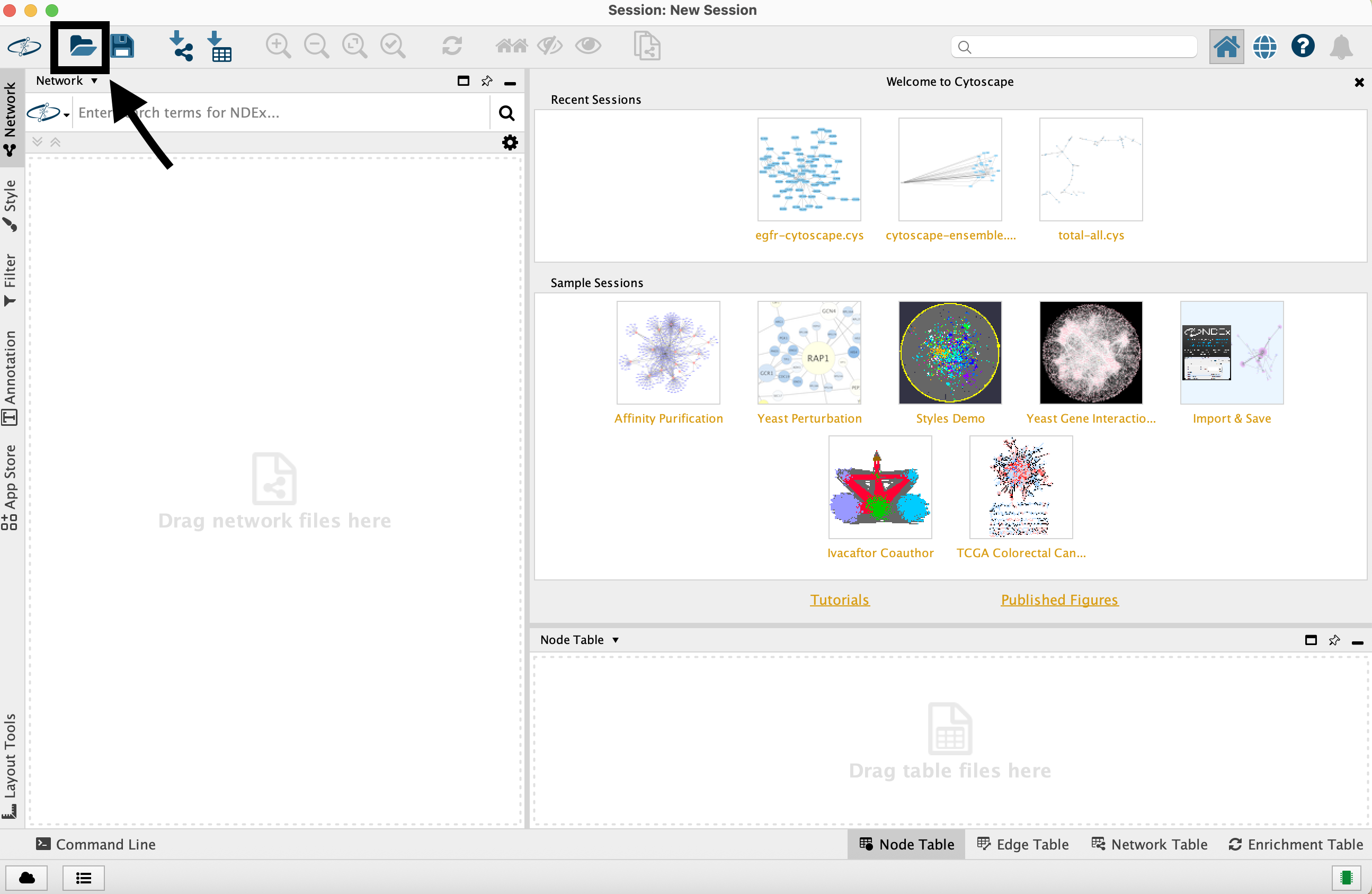

Once loaded, the session will display all reconstructed subnetworks for a given dataset, organized by algorithm and parameter combination.
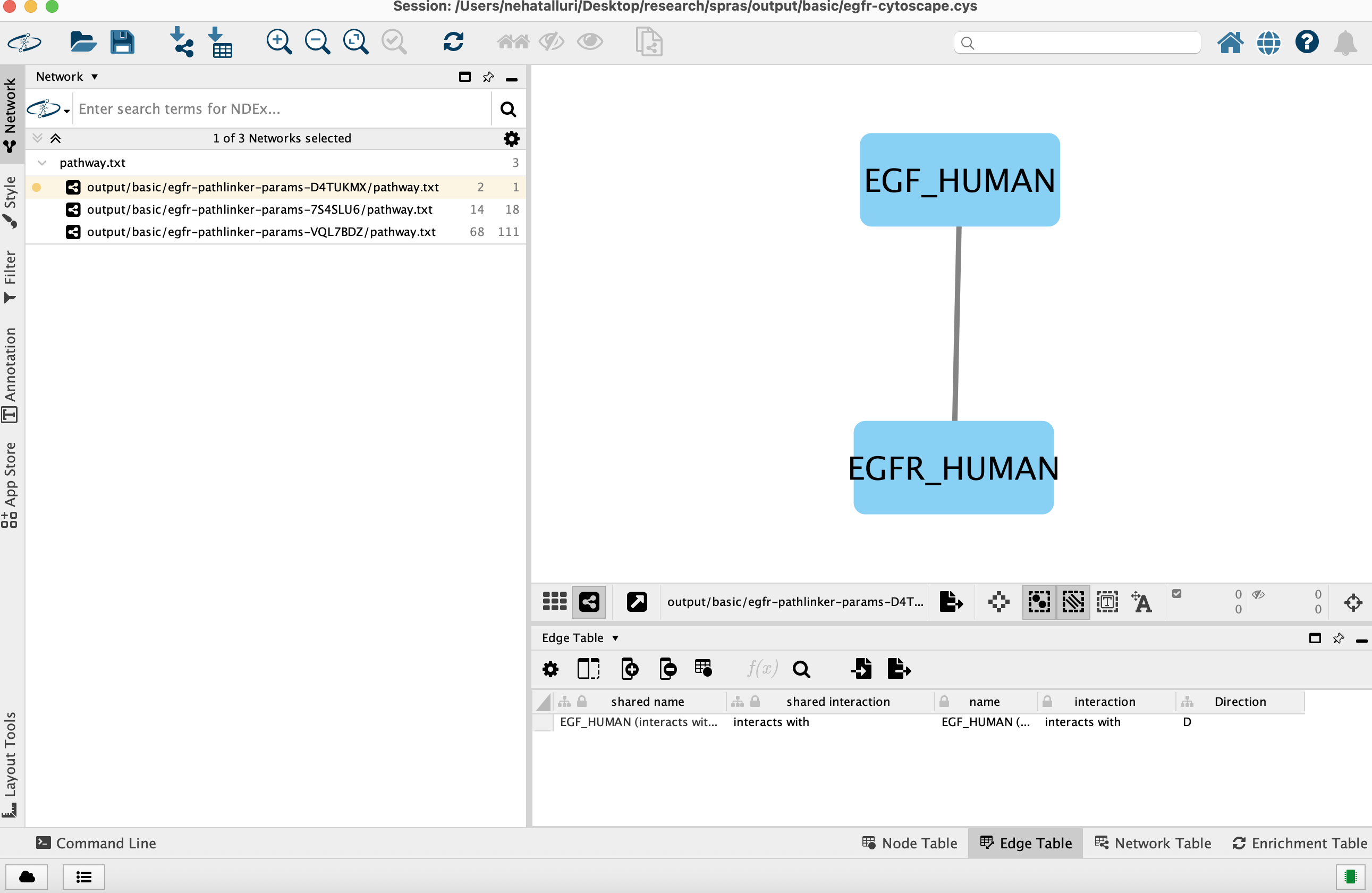
You can view and interact with each reconstructed subnetwork. Compare how the different parameter settings influence the pathways generated.
The small parameter value (k=1) produced a compact subnetwork:
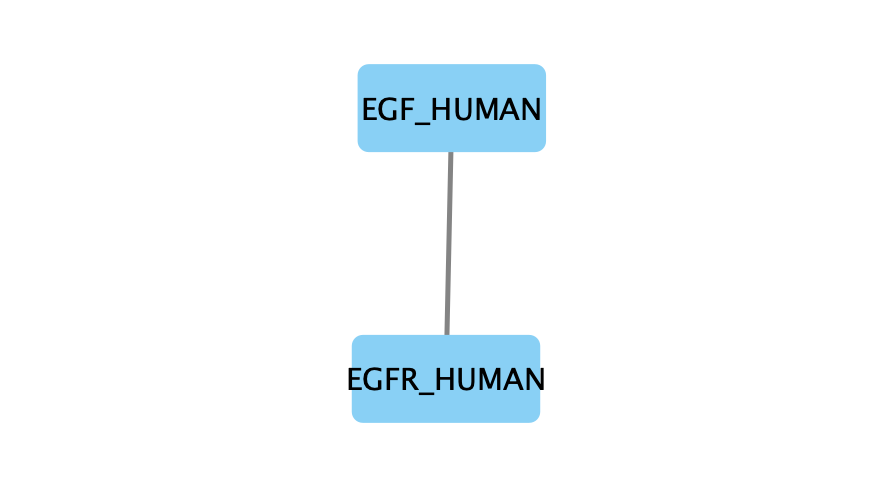
The moderate parameter value (k=10) expanded the subnetwork, introducing additional nodes and edges that may uncover new connections:
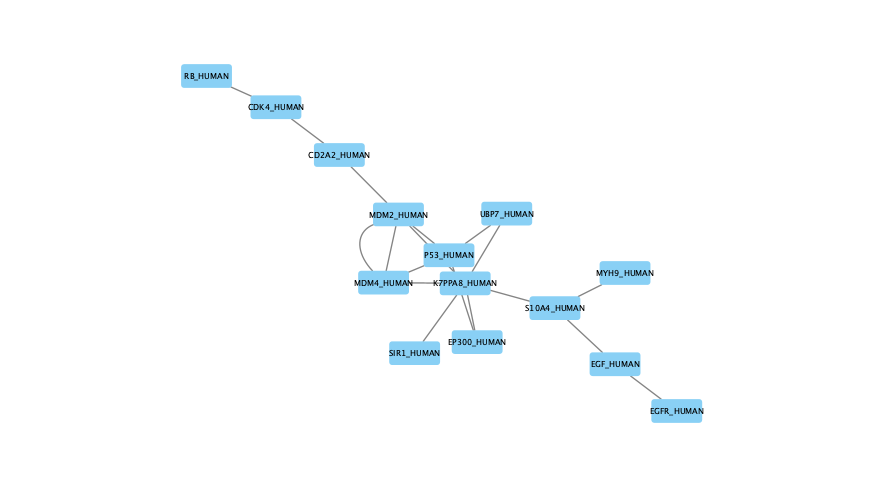
The large parameter value (k=100) generates a much denser subnetwork, capturing a broader range of edges but also could introduce connections that may be less meaningful:
